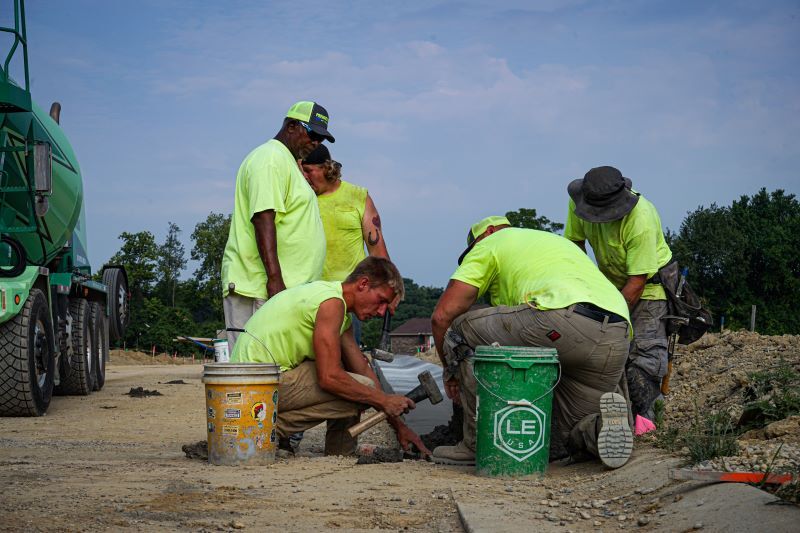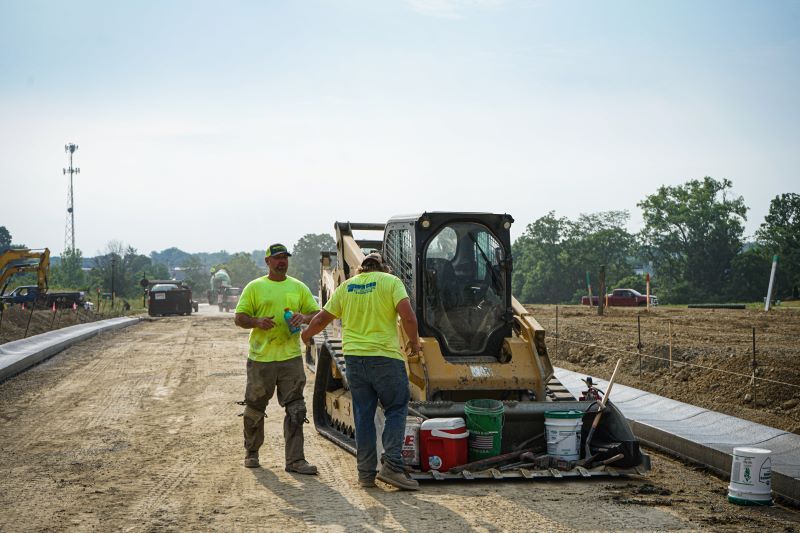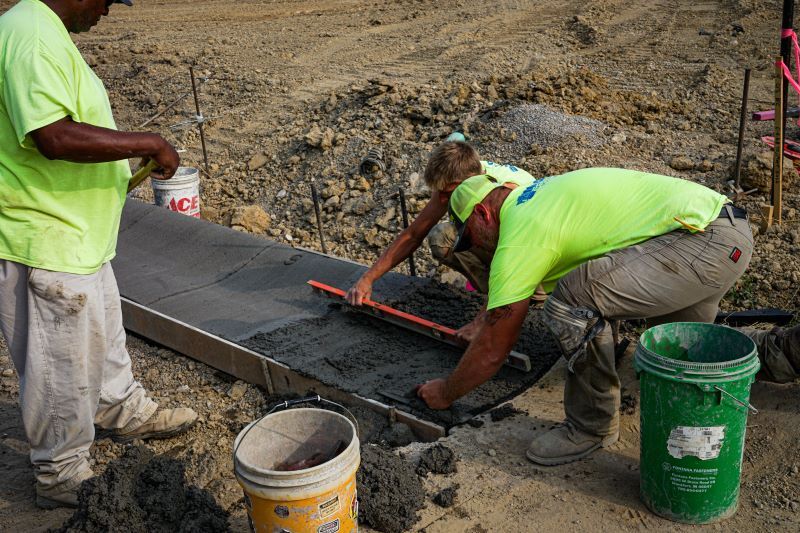What Every General Contractor Needs to Know About Pouring Concrete in Summer Heat
What Every General Contractor Needs to Know About Pouring Concrete in Summer Heat
.jpg)
It’s 6:00 a.m., already 82 degrees, and the pour’s just getting started. Crews are moving fast, trying to beat the heat, but the clock’s ticking—and so is the concrete.
Hot-weather concreting is one of the toughest logistical puzzles a project manager can face. It’s not just the heat—it’s how it affects concrete performance, crew safety, scheduling, and budgets. In the summer months, pouring concrete takes more than skill. It takes foresight, planning, and a team that knows exactly how to adapt on the fly.
This blog isn’t about DIY tips or textbook theory. It’s a field-first guide for general contractors, site owners, and developers who are up against the elements and need to get the job done right.

Why Heat Changes Everything About a Concrete Pour
Concrete might seem indestructible, but it reacts fast to its environment. When the temperature climbs, hydration speeds up, surface moisture disappears, and the entire process becomes a race against the clock. If those conditions aren’t accounted for, the results can compromise strength, finish, and durability.
One of the first issues to watch for is something called plastic shrinkage cracking. Despite the name, this has nothing to do with synthetic plastic. In this case, "plastic" refers to the state of the concrete—while it’s still soft and workable. When surface moisture evaporates too quickly, the top layer starts to contract, forming shallow cracks before the concrete has even begun to harden. Add sun and wind, and those cracks can spread fast.
These early breaks weaken the surface and open the door to concrete shrinkage cracks down the line—especially if curing conditions aren’t corrected quickly.
This is why hot weather concreting requires a different approach. Managing temperature differentials, putting a thermal control plan in place, and coordinating every part of the pour is what keeps summer projects on schedule—and built to last.
What Counts as “Hot Weather” in Concrete Work?
According to the American Concrete Institute (ACI), anything above 77°F (25°C) qualifies as hot weather for concrete placement. But it’s not just the number on the thermometer. High humidity slows evaporation. Wind increases surface drying. Even early morning or overnight pours might not cool things down during a stretch of extreme heat.
That’s why field experience matters. Knowing the best temp to pour concrete is one thing—knowing how to adjust when conditions shift in real time is what separates a good crew from a great one.
What Happens to Concrete in High Heat?
As temperatures rise, the concrete’s internal chemistry speeds up. Hydration—the reaction that allows concrete to set and gain strength—happens too fast under hot conditions, which causes the surface to dry out prematurely.
That leads to slump loss. The mix becomes stiffer, harder to place, and more difficult to finish. It doesn’t flow cleanly into forms, doesn’t bond evenly, and can start drying before the crew is done placing it.
The consequences don’t stop at placement. Research shows that when concrete cures at temperatures above 100°C, it can lose 10–20% of its compressive strength—and as much as 40% at 260°C. These strength reductions compromise the slab’s durability, especially in high-load or exposed applications.
When the heat rises, so do the risks—and there’s less room for error.

Real-World Challenges Contractors Face on Hot-Weather Job Sites
Every experienced contractor has seen what can go wrong during a summer pour. Crews rush. Timing slips. The mix starts flashing off in the truck. And just like that, you’ve got a section that needs to be torn out and redone.
Heat compresses the window for proper placement. It also complicates everything around it—traffic control, site access, delivery timing, and finishing schedules. A pour that should take three hours suddenly has to be completed in two. Or you risk surface cracking, bond failure, or premature hardening.
You can’t just pour faster. You have to pour smarter.
Crew Safety and Fatigue
It’s not just the concrete that suffers. High temperatures wear down your crew, too. When workers push through fatigue and dehydration, mistakes happen. That’s why we prioritize team rotation, enforce hydration protocols, and build in recovery breaks—especially when projects run during peak sunlight hours.
It’s not about comfort. It’s about performance, accuracy, and job site safety. +
Equipment, Mix, and On-Site Prep
Before the first truck even arrives, we’re already working the plan.
That means prepping sunshades, insulating forms, and staging temperature monitoring tools across the site. We use admixtures like water reducers or retarders to control set time and adjust placement speeds.
Even the smallest detail matters—like making sure metal tools aren’t scorching hot to the touch at 7:30 a.m.
Knowing how to pour a concrete slab in summer takes more than a manual. It takes muscle memory, smart tools, and experienced boots on the ground.

The Charles H. Hamilton Approach to Summer Concrete Work
At Charles H. Hamilton, hot-weather pours aren’t a seasonal headache—they’re a routine part of our calendar. We’ve built processes around the realities of Midwest heat, and we don’t leave anything to chance.
That starts with detailed planning: adjusting mix designs for temperature, coordinating truck arrivals to match the forecast, and assigning experienced crews to manage pacing on site. We often pour at sunrise or overnight, when possible, to avoid mid-day spikes that can compromise surface integrity.
Every part of our process—timing the set, selecting curing methods, planning finishing work—is designed to protect concrete strength and avoid rework.
Pouring with Precision
We’ve handled commercial pours in July when the humidity was high and shade was minimal—and still hit specs without a hitch. The difference isn’t luck. It’s how we stage equipment, pace the crew, communicate across the job site, and anticipate how heat will affect every square foot of the slab.
That precision is what our clients count on, especially when projects are tight on time and high on expectations.
Why It Matters for Your Project’s Timeline, Budget, and Results
A summer pour gone wrong doesn’t just look bad. It costs money. It delays inspections. It requires new permits, fresh pours, and sometimes new subgrade work. All of that eats into budgets and throws off project sequencing.
By working with a crew that knows the temperature to pour concrete and how to respond when it changes, you’re not just protecting the slab. You’re protecting your schedule, your client relationship, and your bottom line.
Our methods help avoid costly mistakes—because we’ve already lived through the worst-case scenarios, and we know how to keep them off your site.
Create a Summer-Ready Concrete Plan with Charles H. Hamilton
Got a hot-weather concrete job coming up? Let’s get ahead of it.
Charles H. Hamilton has the experience, tools, and planning strategies to manage summer pours with precision. We’ve handled the toughest conditions, and we know how to keep your project on track—even when the heat is working against you.
Let’s talk now—before the forecast hits triple digits.

